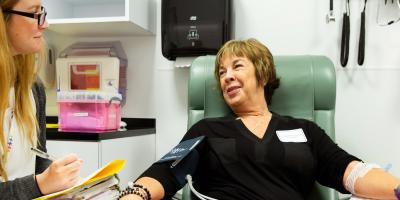
About Clinical Trials
Rapid advances in our knowledge about neurological disorders have led to the development of many new drugs and treatment strategies. However, before these new strategies can be adopted, they must be shown to work in patients.
This means that clinical trials - studies in people to rigorously test how well a treatment works - have become an increasingly important part of medical research. Clinical trials are the primary way that researchers find out if a promising treatment is safe and effective for patients. Clinical trials also tell researchers which treatments are more effective than others. Advances in treatment are only possible through the participation of patients and study partners (a patient’s spouse, family member, caregiver or friend) in clinical trials.
What is a clinical trial?
A clinical trial is a biomedical or health-related research study in patients that follows a pre-defined protocol. Trials take place at private research facilities, teaching hospitals, specialized dementia research centers, and doctors' offices. At the UCSF Memory and Aging Center, researchers conduct both observational and interventional types of studies.
- Observational studies are those in which patients are observed and their outcomes are measured by the investigators. Other information is available from the UCSF Memory and Aging Center about these studies.
- Interventional studies are those in which the patients are assigned by the investigator to a treatment or other intervention, and their outcomes are measured. There are three types of interventional studies conducted at the UCSF Memory and Aging Center.
- Treatment trials test experimental treatments, new combinations of drugs, or new approaches to surgery or radiation therapy.
- Prevention trials look for better ways to prevent disease in people who have never had the disease or to prevent a disease from returning. These approaches may include medicines, vitamins, vaccines, minerals, or lifestyle changes.
- Diagnostic trials are conducted to find better tests or procedures for diagnosing a particular disease or condition.
The information presented here will mainly pertain to interventional studies.
What are the phases of clinical trials?
Clinical trials are conducted in phases. The trials at each phase have a different purpose and help scientists answer different questions.
- In Phase I trials, researchers test an experimental drug or treatment in a small group of people (20-80) for the first time to evaluate its safety, determine a safe dosage range, and identify side effects.
- In Phase II trials, the experimental study drug or treatment is given to a larger group of people (100-300) to see if it is effective and to further evaluate its safety. In Phase III trials, the experimental study drug or treatment is given to large groups of people (1,000-3,000) to confirm its effectiveness, monitor side effects, compare it to commonly used treatments, and collect information that will allow the experimental drug or treatment to be used safely.
- In Phase IV trials, post marketing studies delineate additional information including the drug's risks, benefits, and optimal use.
Where do the ideas for trials come from?
Ideas for clinical trials usually come from scientists at research universities and pharmaceutical companies. After scientists test new therapies or procedures in the laboratory and in animal studies, the experimental treatments with the most promising laboratory results are moved into clinical trials in humans. During a trial, more and more information is gained about an experimental treatment, its risks, and how well it may or may not work. (See Promising Therapies for more information.)
Who pays for the research?
A clinical research study is paid for by the organization that sponsors the research. If the research is sponsored by the government, it may be paid for through a grant awarded to the doctors and scientists who conduct the research.
Some research studies are sponsored and paid for by drug and medical device companies. Other studies are paid for by private foundations for specific diseases, by gifts to the university or scientist, or by the researcher’s department at the medical center.
What is a control or control group?
A control is the standard by which experimental observations are evaluated. In many clinical trials, one group of patients will be given an experimental drug or treatment, while the control group is given either a standard treatment for the illness or a placebo.
What is a placebo?
A placebo is an inactive pill, liquid, or powder that has no treatment value. In clinical trials, experimental treatments are often compared with placebos to assess the experimental treatment's effectiveness. In some studies, the participants in the control group will receive a placebo instead of an active drug or experimental treatment.